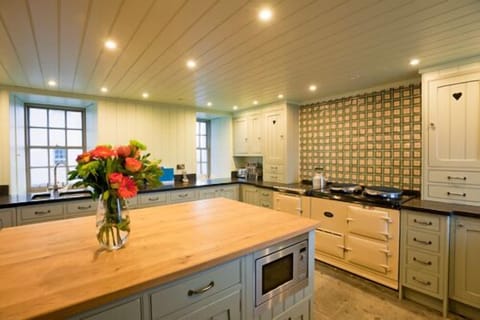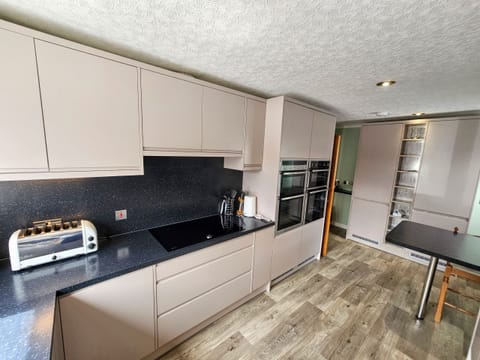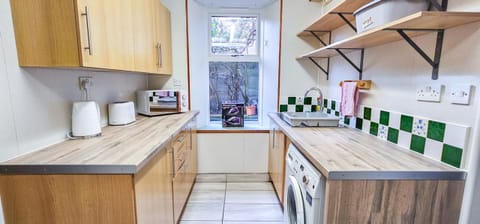BALNAKEIL HOUSE - A-Listed Highland Mansion on the Beach sleeping up to 17





House in Scotland
17 guests · 9 bedrooms · 6 baths
Reasons to book
Free cancellationFull refund if you change your mind
Great for petsBring all your friends and family, even the furry ones
Includes essentialsGarden, Pets allowed, Kitchen or Kitchenette and more
About this house rental
Balnakeil House is an A-listed nine-bedroom highland mansion which sleeps up to 17. Now fully restored it has been sympathetically refurbished to provide a unique and luxurious experience.
The setting is magical, all rooms have spectacular sea or mountain views. Step out the back door and onto the mile and a half long white sandy beach of Balnakeil Bay. Step into a timeless décor of earthy colours in sympathy with the surroundings, solid wooden furniture and heated slate floors, lovely muted plaids and tweeds from Anta.
Enter to find the superbly equipped kitchen with an Aga at one end, and a stove at the other separated by a 4.5m long oak table, it makes the perfect spot to gather and socialise whilst preparing and enjoying meals.
A games room with a pool table, board games, books, DVDs, stove, a comfy sofa and a flat screen TV will keep the young at heart entertained, whilst those requiring quieter moments can rest in the sumptuous drawing room upstairs, with a fantastic view over the beach, before all joining up for dinner in the breathtaking dining room.
The nine bedrooms are welcoming and exceptionally comfortable, with crisp white linen over memory foam mattresses.
A maximum of two dogs are welcome. The property has a strict pet policy, please enquire on booking.
The History of Balnakeil House
It is believed that building of the original Balnakeil House was begun around 1642 and it was then rebuilt c. 1744 and extended a few times in the 1800's, but there is no known authoritative work documenting this.
Balnakeil House was built by the Mackay chiefs as a family mansion on the site of an earlier building which had at one time been the summer palace of the medieval Bishops of Caithness. There is little by way of contemporary documentation on the building itself but plenty of stories about the place and its inhabitants. The first occupant of the rebuilt mansion, Donald, son of the third Lord Reay was, according to poet Rob Donn, "the apex of society and entertainment, of the men of poetry and of music". In 1740, the minister in the nearby manse, the Rev Murdo Macdonald, wrote in his diary that he couldn't concentrate on composing his Sunday sermons for all the merrymaking going on at the house on Saturday evenings!
From the early 1800s Balnakeil was occupied by the sheep farm tenant, beginning with John Dunlop. The last occupants were the previous farm manager and his family, the Andersons. Balnakeil House has lain empty since 1992.
Melness-based author Mary Beith has written: "By the end of the seventeenth century, the Reay Forest, including Glen Golly, had been subject to Sutherland's [sic] earliest and least publicised clearance when a chief of Mackay moved the people to Eddrachillis in the west to make way for what may well have been, ironically, both the Highland's first purpose-planned sporting estate and one of the last resorts of a truly indigenous luxury lifestyle.
"At Balnakeil House in Durness, John, Lord of Mackay, held sway over what the historian Edward Cowan has called "an almost aggressively traditional household". When the then Lord Lovat visited John Mackay in 1669 there was hawking, hunting, sea fishing, archery, wrestling, feasting, music and dancing. Among other household retainers, Mackay had a piper, a harpist and an amadan (Gaelic: fool or jester). When he left, Lovat was showered with gifts a sheltie, guns, longbows, an antique sword, a pair of deerhounds, a silk plaid and a doublet and trews."
In his book "The world of Rob Donn" (Edinburgh, 1979, although a new edition has now been issued) Ian Grimble wrote: "Second in magnificence to the seat of the chief at Tongue stood his mansion in the far west. This ancient manor farm had been inhabited by the second Lord Reay while Tongue House was being rebuilt, and it was used besides as a hunting lodge for expeditions to the Reay Forest, as a granary the chief's western estates, and as the residence of his heir. Like Tongue House it remains exactly as Rob Donn saw it, though it has also lost all its eighteenth century furnishings." According to Dr Grimble, Balnakeil was built by the second Lord Reay who was educated in Denmark while his father was fighting with his clan regiment in the Thirty Years' War, "and it may not be fanciful to see in its architecture the influence of the Danish manor-farm".
Another story related by Ian Grimble tells how the wife of a Mackay chief, a Sutherland by birth, helped save Kenneth Sutherland, an army deserter who had fled to Durness during or shortly after the 1745 rebellion. A detachment of troops caught up with him at Balnakeil. "Whether by accident or design, Kenneth Sutherland did not choose one of the doors leading to the ground-floor premises when he bolted through the garden and across the court. He chose the entrance which took him to these narrow stairs. At the head of them can still be seen the little closet beside the panelled reception room into which Lady Reay pushed her clansman in his extremity. She then welcomed his pursuers as they tumbled up the stairs, ushering them into the great room beyond Kenneth's hiding place. She ordered drink for them; she summoned the women who were working about the premises and improvised a dance."
"There was a lady beside the threshold / Standing there, alert, formidable. / I don't know the pass / He went out by, on my life / But between the woman's legs, / Without bonnet or weapons, / Very near the fissure where he was born, / There he made his escape." The double entendre got lost in the translation, apparently.
"Lady Reay's resourcefulness in smuggling the deserter to safety down that narrow staircase beneath a woman's skirts was not the only theme she provided for Rob Donn," Dr Grimble commented.
Balnakeil House was listed in 1971 by Historic Scotland as a category "A" building, which makes it of national importance, placing it in the top seven-and-a-half per cent of listed buildings. The escription reads: "1744. Two storey and attic, symmetrical U-plan house; four centre bays, rojecting outer wings with 3-bay inner faces to small paved court; two first floor and small attic windows only in south facing outer gabled wings. All harled, with polished ashlar margins and dressings." The interior is a mixture of original features and nineteenth century alterations and decoration (wood panelling etc.). The walled garden is dated 1863.
Works on the House started in late 2009, following lengthy discussions with Historic Scotland, and the house has now been sympathetically refurbished to form a comfortable large house.
Elliot Houses look forward to welcoming you to Balnakeil House!
The setting is magical, all rooms have spectacular sea or mountain views. Step out the back door and onto the mile and a half long white sandy beach of Balnakeil Bay. Step into a timeless décor of earthy colours in sympathy with the surroundings, solid wooden furniture and heated slate floors, lovely muted plaids and tweeds from Anta.
Enter to find the superbly equipped kitchen with an Aga at one end, and a stove at the other separated by a 4.5m long oak table, it makes the perfect spot to gather and socialise whilst preparing and enjoying meals.
A games room with a pool table, board games, books, DVDs, stove, a comfy sofa and a flat screen TV will keep the young at heart entertained, whilst those requiring quieter moments can rest in the sumptuous drawing room upstairs, with a fantastic view over the beach, before all joining up for dinner in the breathtaking dining room.
The nine bedrooms are welcoming and exceptionally comfortable, with crisp white linen over memory foam mattresses.
A maximum of two dogs are welcome. The property has a strict pet policy, please enquire on booking.
The History of Balnakeil House
It is believed that building of the original Balnakeil House was begun around 1642 and it was then rebuilt c. 1744 and extended a few times in the 1800's, but there is no known authoritative work documenting this.
Balnakeil House was built by the Mackay chiefs as a family mansion on the site of an earlier building which had at one time been the summer palace of the medieval Bishops of Caithness. There is little by way of contemporary documentation on the building itself but plenty of stories about the place and its inhabitants. The first occupant of the rebuilt mansion, Donald, son of the third Lord Reay was, according to poet Rob Donn, "the apex of society and entertainment, of the men of poetry and of music". In 1740, the minister in the nearby manse, the Rev Murdo Macdonald, wrote in his diary that he couldn't concentrate on composing his Sunday sermons for all the merrymaking going on at the house on Saturday evenings!
From the early 1800s Balnakeil was occupied by the sheep farm tenant, beginning with John Dunlop. The last occupants were the previous farm manager and his family, the Andersons. Balnakeil House has lain empty since 1992.
Melness-based author Mary Beith has written: "By the end of the seventeenth century, the Reay Forest, including Glen Golly, had been subject to Sutherland's [sic] earliest and least publicised clearance when a chief of Mackay moved the people to Eddrachillis in the west to make way for what may well have been, ironically, both the Highland's first purpose-planned sporting estate and one of the last resorts of a truly indigenous luxury lifestyle.
"At Balnakeil House in Durness, John, Lord of Mackay, held sway over what the historian Edward Cowan has called "an almost aggressively traditional household". When the then Lord Lovat visited John Mackay in 1669 there was hawking, hunting, sea fishing, archery, wrestling, feasting, music and dancing. Among other household retainers, Mackay had a piper, a harpist and an amadan (Gaelic: fool or jester). When he left, Lovat was showered with gifts a sheltie, guns, longbows, an antique sword, a pair of deerhounds, a silk plaid and a doublet and trews."
In his book "The world of Rob Donn" (Edinburgh, 1979, although a new edition has now been issued) Ian Grimble wrote: "Second in magnificence to the seat of the chief at Tongue stood his mansion in the far west. This ancient manor farm had been inhabited by the second Lord Reay while Tongue House was being rebuilt, and it was used besides as a hunting lodge for expeditions to the Reay Forest, as a granary the chief's western estates, and as the residence of his heir. Like Tongue House it remains exactly as Rob Donn saw it, though it has also lost all its eighteenth century furnishings." According to Dr Grimble, Balnakeil was built by the second Lord Reay who was educated in Denmark while his father was fighting with his clan regiment in the Thirty Years' War, "and it may not be fanciful to see in its architecture the influence of the Danish manor-farm".
Another story related by Ian Grimble tells how the wife of a Mackay chief, a Sutherland by birth, helped save Kenneth Sutherland, an army deserter who had fled to Durness during or shortly after the 1745 rebellion. A detachment of troops caught up with him at Balnakeil. "Whether by accident or design, Kenneth Sutherland did not choose one of the doors leading to the ground-floor premises when he bolted through the garden and across the court. He chose the entrance which took him to these narrow stairs. At the head of them can still be seen the little closet beside the panelled reception room into which Lady Reay pushed her clansman in his extremity. She then welcomed his pursuers as they tumbled up the stairs, ushering them into the great room beyond Kenneth's hiding place. She ordered drink for them; she summoned the women who were working about the premises and improvised a dance."
"There was a lady beside the threshold / Standing there, alert, formidable. / I don't know the pass / He went out by, on my life / But between the woman's legs, / Without bonnet or weapons, / Very near the fissure where he was born, / There he made his escape." The double entendre got lost in the translation, apparently.
"Lady Reay's resourcefulness in smuggling the deserter to safety down that narrow staircase beneath a woman's skirts was not the only theme she provided for Rob Donn," Dr Grimble commented.
Balnakeil House was listed in 1971 by Historic Scotland as a category "A" building, which makes it of national importance, placing it in the top seven-and-a-half per cent of listed buildings. The escription reads: "1744. Two storey and attic, symmetrical U-plan house; four centre bays, rojecting outer wings with 3-bay inner faces to small paved court; two first floor and small attic windows only in south facing outer gabled wings. All harled, with polished ashlar margins and dressings." The interior is a mixture of original features and nineteenth century alterations and decoration (wood panelling etc.). The walled garden is dated 1863.
Works on the House started in late 2009, following lengthy discussions with Historic Scotland, and the house has now been sympathetically refurbished to form a comfortable large house.
Elliot Houses look forward to welcoming you to Balnakeil House!
Amenities
Pets allowed
Kitchen or Kitchenette
Internet / Wifi
Parking
Laundry
Dishwasher
TV
Garden
Family friendly
Map of Scotland
FAQs
How much does this house cost compared to others in Scotland?
The average price for a rental in Scotland is $163 per night. This rental is $945 above the average.
Is parking included with this house?
Yes, parking is listed as an amenity at BALNAKEIL HOUSE - A-Listed Highland Mansion on the Beach sleeping up to 17. For more information, we encourage you to contact the property about where to park.
Is there a pool at this house?
We didn’t find pool listed as an amenity for this house. It may be worth double checking if a pool is important for your stay.
Is BALNAKEIL HOUSE - A-Listed Highland Mansion on the Beach sleeping up to 17 pet friendly?
Yes! This house is pet-friendly. For more information, we recommend contacting the booking provider about animal policies.
What amenities are available at BALNAKEIL HOUSE - A-Listed Highland Mansion on the Beach sleeping up to 17?
We found 9 amenities for this rental. This includes pets allowed, kitchen or kitchenette, internet / wifi, parking, and laundry.
Explore similar vacation rentals in Scotland
Explore all rentals in ScotlandScotland travel inspiration
Read our blogGuides
Visit These 9 UK Tourist Attractions for a Taste of Royal Life
Budget Travel
Travel the UK on a Budget: Affordable Cities & Attractions
Guides
10 Best UK Cities for Solo Travelers
Research
How to Avoid “Tourist Traps” in the Most Popular Cities
Guides
How to Make the Most Out of 48 Hours in Edinburgh, Scotland
Guides
What Are the Best Neighborhoods to Stay in Edinburgh, Scotland?
Guides
A Step-by-Step Guide to Building the Ultimate Travel Bucket List
Guides
Folklore Travel Guide: Finding Bigfoot, Loch Ness Monster & More






























